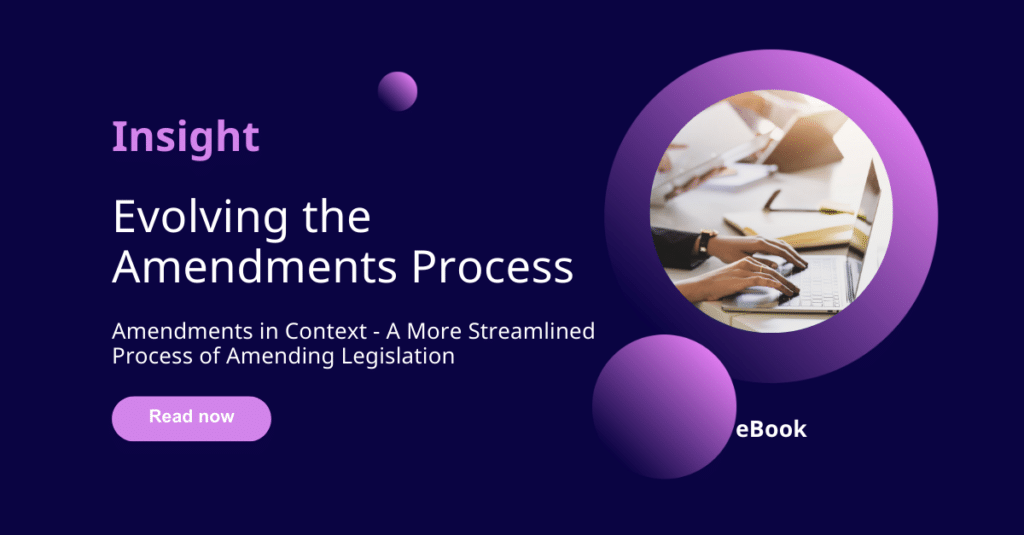The Past, Present & Future of Amendment Drafting
Amendment drafting has seen an interesting and rich history of evolving methods as both time and technology has advanced. There have been several different amendment drafting processes in place that have led to today’s current methods of documenting amendments to legislation.
From the humble beginnings of handwritten amendments, to upgrading to typed amendments with the introduction of typewriters, the mainframe, and modern technology, the method of amendment drafting has constantly improved to speed up the process and make it more efficient and beneficial for members, staff, and the public.
When looking towards the future of amendment drafting, it is important to consider who consumes amendments today. The variety of consumers is the reason why it is imperative to continually evolve the amendment drafting and publishing process. Amendments must remain accessible and understandable to those who need or seek to access them in order to stay informed on proposed changes to legislation.
Any changes to amendment drafting methods must still adhere to the two following amendment facets:
- Maintain the integrity of the amendment by having a record of all proposed changes and a record of what has been adopted and not adopted.
- Provide the ability to report on the evolution of the bill to maintain transparency and allow users to go back and track historical changes.
The method of amendment drafting has constantly improved to speed up the process and make it more efficient and beneficial for members, staff, and the public.
Amendments in Context
One alternative approach to the page and line number instructions used in amendment drafting is to solely use the Amendment in Context (AIC) document. This AIC document displays the amendment edits in the context of the Bill, instead of producing page and line number amendment instructions. It is a direct copy, or delta, of the bill to be amended that drafting attorneys and legal staff can edit. In this delta, all edits made to the bill are fully tracked using color track changes to show the insertions and deletions.
Once these edits have been made, the user can then generate a page and line Amendment Report. AIC also allows users to create a ‘Section Amendment’ so drafting attorneys can select the individual sections they wish to amend and produce a replica, or delta, with only the selected sections present within the document.
The Amendment in Context provides an easy-to-comprehend view of what the amendment aims to achieve. It gives you a thorough audit trail to understand how a bill has been amended and the ability to navigate directly to a change to see the impact of the amendment. You can read more about Amendments in Context in our eBook here.
One State that has taken the leap and begun streamlining their amendment drafting process using The Amendment in Context is North Dakota.
North Dakota’s Evolving Amendment Drafting Process
Prior to the availability of modern computer software and the ability to track changes within a digital document, a drafting attorney had to provide written instructions on how a bill was to be modified. These amendment instructions were used by a typist to manually create a new version of the bill. This was the process used in North Dakota for amendment drafting prior to their modernization.
The drafting process in North Dakota was modernized with the implementation of the LEGEND drafting system based on the LWB 360 platform. This allowed a drafting attorney to type the changes directly into the text of an exact replica of the Bill (i.e. the Amendment in Context document) to create a ‘marked-up’ or ‘Christmas tree’ version of the Bill. The new drafting system then used the edits in the Amendment in Context to generate the traditional Amendment Instruction document.
North Dakota decided to continue modernizing the drafting process by removing outdated practices. They did this through adopting the Amendment in Context as their single source of truth for amendment drafting.
The marked-up Amendment in Context document, which was initially created as a tool of convenience for the drafting attorney, soon became the document of choice for legislators. Viewing stricken red and green changes within the text of a document was much easier for legislators to read. It eliminated the effort of trying to read the introduced version of the Bill alongside a set of amendment instructions.
Transitioning to this more user-friendly and intuitive marked-up option provides the greatest benefit to legislators. Especially considering the increased turnover anticipated due to the State’s recent adoption of term limits.
Eliminating the use of amendment instructions benefits both the legislative process and the legislative staff in numerous ways. These include:
- The opportunity for discrepancies between the amendment instructions and the marked-up version is removed.
- The amount of time and effort expended on overtime due to proofing amendment instructions is reduced.
- The turnaround time for amendments is decreased.
- The readability of the journals has improved by linking to the marked-up version of the Bill rather than printing the amendment instructions within the text of the journals.
These benefits have a substantial impact considering North Dakota is the most sparsely staffed legislative service agency in the nation. As this method is still being implemented, we hope to see the benefits continue with North Dakota’s efforts to continuously improve and modernize their amendment drafting process.
Transitioning to this more user-friendly and intuitive marked-up option provides the greatest benefit to legislators.
Looking Towards the Future
While it is important to maintain ties to historical practices and respect the methodologies currently in place, it is also imperative to continuously evolve the amendments process as time and technology advances. This can be easily seen and justified by examining the history of amendment drafting.
Today, we have the technology to not only continue improving the speed, efficiency, and benefits for drafting attorneys and legal staff, but also enhance the experience for members, the public, special interest groups, and all other consumers of amendments. Streamlining the process while preserving the integrity of the amendment, keeping a record of changes, and producing a report on the evolution of the bill are all fully achieved by using the Amendment in Context approach in LWB 360.
While we await the results of a full implementation of this method in North Dakota, why not reach out to us today for more information on Amendments in Context here, or find out how AIC could benefit your State by requesting a demo here.


